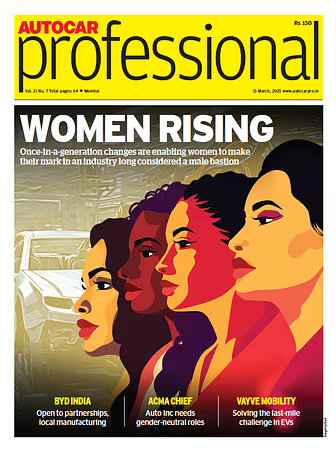Skoda uses augmented reality to load components onto pallets
Augmented reality projections support logistics when packing Medium Knocked Down kits for export markets; laser projections indicate correct position for a part on the pallet; text, images and videos explain individual work processes.
Augmented reality technology is supporting logistics staff in the CKD Centre at Skoda Auto's Mladá Boleslav plant. As part of a large-scale trial, video mapping projections assist staff when loading sets of MKD (Medium Knocked Down) components onto pallets ready for export.
Laser projections indicate the correct position for a part on the pallet. In addition, text, images and videos provide information on how to optimally secure and protect the components. The system notices when a part has been placed incorrectly and helps workers to correct this.
The term ‘video mapping’ refers to a method that allows images to be projected onto a surface accurately and without any distortion. This technology is also being used in the CKD Centre at Skoda Auto's headquarters as part of a pilot project, displaying information on a particular component, carrier or on the Centre’s hall floor.
Michael Oeljeklaus, Skoda Auto Board Member for Production and Logistics, explained, “Video mapping technology opens up totally new opportunities for us in Logistics. Our employees are supported by this Industry 4.0 technology when preparing for the dispatch of our component kits for certain export markets. In this way, augmented reality minimises the error rate when loading MKD kits onto large export pallets and additionally increases safety in the working environment.”
The video mapping system consists of an ultra-high-resolution laser projector and an HD camera. It is the first augmented reality system at Skoda Auto not to require the employees to wear 3D goggles. At present, the technology is comprehensively tested and further developed accordingly. One challenge is to adjust the cameras to intensity of the lighting in the hall, so that the devices can also reliably capture their surroundings in these conditions.
First during the loading process, a set of MKD components is transported to the loading area on a wheeled carrier, where a large pallet, a ‘rack’, awaits. As soon as an employee scans the component´s serial number, a laser projectors point to the exact location on the pallet where this component is to be placed. Additional assistance is provided by images and text projected onto the hall floor, explaining how the parts are to be secured and protected. The system recognises if the wrong part has been scanned and loaded, and provides a corresponding notification in such an event.
The use of augmented reality also helps in other areas: as there is no longer any need to print documents in this process, the CKD Centre is saving a large amount of paper, thus realising objectives of Skoda’s ‘Green Future’ Strategy, aimed at sustainability and protecting the environment.
Being cornerstones of Skoda Auto’s 2025 Strategy, digitalisation and Industry 4.0 solutions affect all business areas, ranging from logistics to vehicle development as well as training and CPD, by using modern virtual reality and 3D technology. Entering the era of electromobility is another key pillar of Skoda’s 2025 Strategy. The Czech car manufacturer will launch the Superb featuring plug-in-hybrid drive as well as an all-electric variant of the Citigo this year.
RELATED ARTICLES
US tariffs will hurt both automakers and US manufacturing: ACEA
European Automobile Manufacturers’ Association says that the EU and the US must engage in dialogue to find an immediate ...
Trump levies 25% tariff on all cars imported to US
President Donald Trump claims new levy on all cars and car parts shipped into the country will create "tremendous growth...
Hyundai opens its third factory in the US: Metaplant America
Hyundai Motor Group Metaplant America's vehicle assembly and battery plant is the key pillar of the Hyundai Motor Group’...






 By Autocar Pro News Desk
By Autocar Pro News Desk
 16 Mar 2019
16 Mar 2019
 12167 Views
12167 Views














